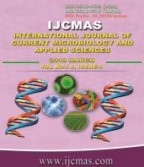


 National Academy of Agricultural Sciences (NAAS)
National Academy of Agricultural Sciences (NAAS)

|
PRINT ISSN : 2319-7692
Online ISSN : 2319-7706 Issues : 12 per year Publisher : Excellent Publishers Email : editorijcmas@gmail.com / submit@ijcmas.com Editor-in-chief: Dr.M.Prakash Index Copernicus ICV 2018: 95.39 NAAS RATING 2020: 5.38 |
The present study was conducted during the Rabi seasons of 2014-15 and 2015-16 at SIF Farm of Chandra Shekhar Azad University of Agriculture & Technology, Kanpur, Uttar Pradesh, India to find out suitable superimposed nutritional doses for increase in production, productivity and economics of chickpea in Central Plain Zone. The treatments consisted seven (7) superimposed doses of sulphur (25 kg ha-1), Boron (1.0 kg ha-1), FYM (5.0 t ha-1) used a individually, Rhizobium culture + FYM, Sulphur+ Boron, Sulphur + Boron + FYM, Sulphur + Boron + FYM + Rhizobium in combination along with NPK (20:60:20 kg ha-1) doses compared with only NPK (20:60:20 kg ha-1) dose (control treatment). The experiments were laid out in Randomized Block Design, replicated three times. The response of above treatments is analyzed on growth parameters, yield attributes and yield as well as quality of chickpea, variety KWR-108. The superimposition effect of sulphur, Boron, FYM and Rhizobium species along with NPK doses in different treatment exhibited significant response is terms of increasing grain yield to the tune of 23 percent to 62 percent compared to control treatment. Among different treatments superimposed doses of NPK (20:60:20 kg ha-1) + Sulphur (25 kg ha-1) + Boron (1.0 kg ha-1) + FYM (5.0 t ha-1) + Rhizobium inoculation treatment recorded maximum grain yield (1348.14 kg ha-1 and 1873.21 kg ha-1), Nitrogen content (3.34% and 3.37%), Phosphorus content (1.46% and 1.47%), Potash content (0.65% and 0.67%), Sulphur content (0.61% and 0.63%) and Boron content (57 ppm and 58 ppm) in grain during 2014-15 and 2015-16, respectively compared to NPK only (control) treatment, which recorded lowest grain yield (1000.73 kg ha-1) and 1154.54 kg ha-1), Nitrogen content (3.18% and 3.20%), Phosphorus content (1.23% and 1.25%), Potash content (0.47% and 0.49%), Sulphur content (0.43% and 0.45%) and Boron content (41 ppm and 42 ppm) in grain during 2014-15 and 2015-16, respectively.
 |
 |
 |
 |
 |